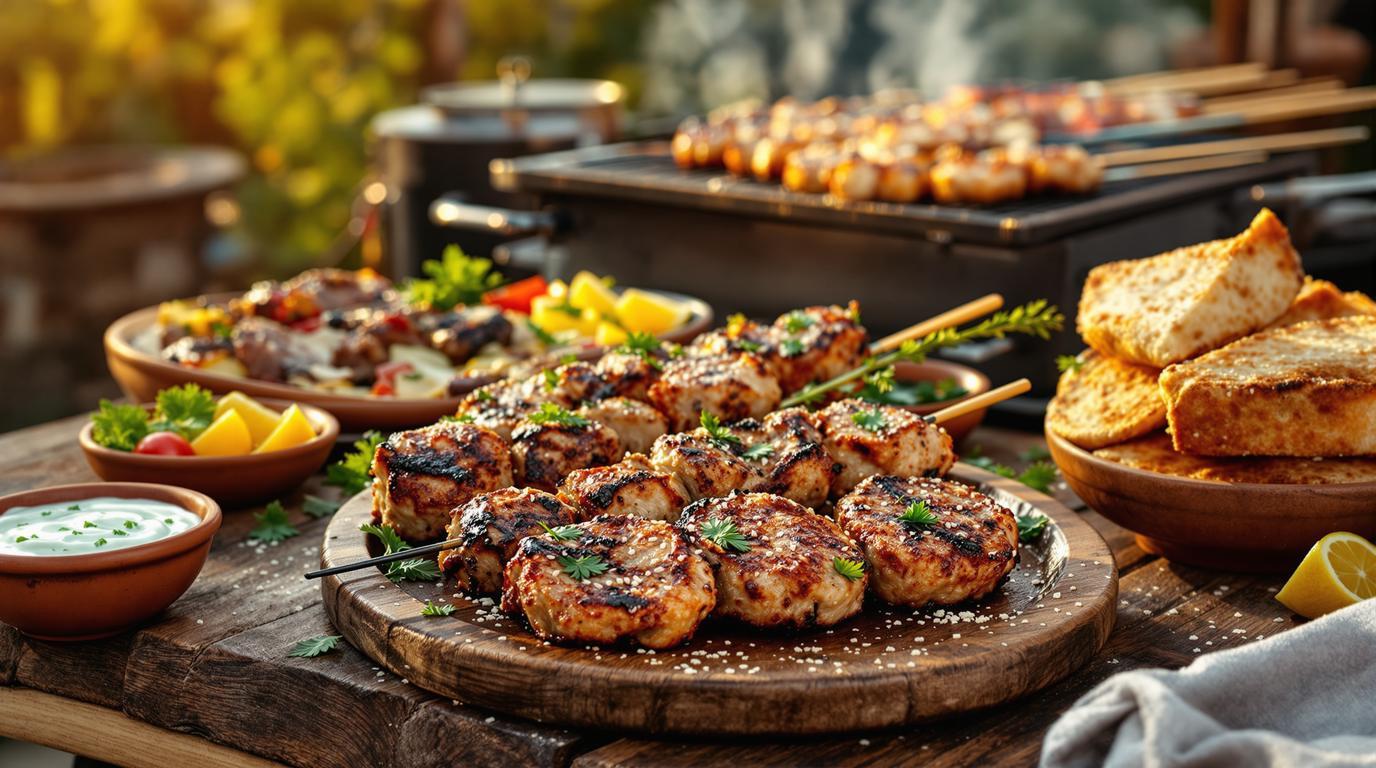The first time I tried creating a DIY kebab station at home, I was attempting to recreate the magic of those bustling street vendors in Istanbul. The sizzle of meat against hot metal, the warm bread enveloping perfectly spiced meat, and the medley of condiments creating that perfect bite. What began as a culinary experiment has become my go-to entertaining setup. While traditional kebabs require vertical spits (a cooking method dating back to the Ottoman Empire), I’ve developed techniques to achieve authentic flavors using standard home equipment. The secret? Layering flavors through proper marination and cooking technique.
The Art of Building Your Kebab Station 🌯
Creating a DIY kebab station is about balancing tradition with practicality. In Azerbaijan, kebabs (known locally as “lyulya”) are often prepared by grandmothers who insist that good meat needs minimal seasoning—just the kiss of fire and smoke. Meanwhile, Turkish doner offers a more complex flavor profile with its aromatic spice blends. I’ve combined both approaches to create the ultimate kebab experience that honors these rich culinary traditions.
Essential Components 🧅
For the Chicken Doner Kebab:
- 1.5kg (3.3 lbs) boneless chicken thighs
- 2 tablespoons sumac (the tangy, crimson spice that’s essential to authentic flavor)
- 2 tablespoons olive oil
- 2 garlic cloves, minced
- 1 tablespoon lemon juice
- 1 teaspoon salt + ½ teaspoon black pepper
For the Azerbaijani-Style Lamb Kebabs:
- 500g (1.1 lbs) ground lamb or beef
- ½ cup onion, finely chopped
- 2 tablespoons breadcrumbs
- 1 teaspoon black pepper + ½ teaspoon turmeric
- 1 egg (crucial for binding)
For the Homemade Pide Bread (worth the effort, trust me):
- 500g (4 cups) all-purpose flour
- 250g (1 cup) lukewarm water
- 7g (2¼ teaspoons) active dry yeast + 1 teaspoon sugar
- 50g (3½ tablespoons) butter, softened
- 2 teaspoons sea salt
- Sesame seeds (optional but traditional)
Preparation: The Dance of Flavors 🔥
1. Marinate the chicken: Combine chicken with sumac, olive oil, garlic, lemon juice, salt, and pepper. The acidity in the lemon juice doesn’t just add flavor—it breaks down muscle fibers, creating tenderness. Refrigerate for at least 2 hours, preferably overnight.
2. Prepare the lamb mixture: In a large bowl, combine ground lamb with onion, breadcrumbs, spices, and egg. Mix thoroughly with your hands (wear gloves to keep your fingernails clean). Shape into small, flat, oval patties about 3 inches long.
Chef’s Note: The texture of your lamb kebabs depends on how you handle the meat. Mix just until combined—overworking will make them tough. I learned this watching my mentor’s grandmother in Baku, who would gently fold rather than knead the mixture.
3. Make the pide dough: Dissolve yeast and sugar in lukewarm water. Wait 5 minutes until foamy. Mix flour and salt, then incorporate the butter and yeast mixture. Knead for 10 minutes until smooth and elastic. Cover and let rise for 1 hour until doubled.
4. Shape and bake the pide: Divide dough into 6 portions. Roll each into 10-inch rounds. Brush with water and sprinkle with sesame seeds. Bake at 390°F (200°C) for 20 minutes until golden brown.
5. Grill your kebabs: For chicken, grill pieces over medium-high heat for 5 minutes per side until juices run clear. For lamb patties, grill 4-5 minutes per side until nicely browned but still juicy inside.
Assembly: The Final Symphony 🍽️
Arrange your station with sliced grilled meats, warm pide bread, and an array of accompaniments:
- Cool tzatziki yogurt sauce
- Pickled vegetables for brightness
- Fresh herbs like mint and parsley
- Thinly sliced onions soaked briefly in lemon juice
The contrast between the hot, spiced meat, soft bread, and cool, crunchy accompaniments creates that magical street food experience we all crave. If you can’t find sumac, paprika mixed with a bit of lemon zest makes a reasonable substitute, though the flavor profile will be slightly different.
My friends still talk about the kebab station I created for my brother’s 40th birthday. There’s something deeply satisfying about watching people build their perfect bite—some loading up on tzatziki, others going heavy on the pickles or hot sauce. It’s exactly what I love about cooking: creating a framework for joy that others can customize to their heart’s content. Like my first chef mentor used to say, “We don’t just feed stomachs—we feed souls.” Try this setup for your next gathering, and you’ll see exactly what he meant.
For more Mediterranean inspiration, check out my whole cauliflower transformation or these smoky Toulouse sausages. If you’re pasta-inclined, my rigatoni alla gricia is effortlessly elegant. For Japanese flavor enthusiasts, try my 24-hour tonkotsu ramen, or celebrate spring with grilled asparagus with lemon and pistachios.
